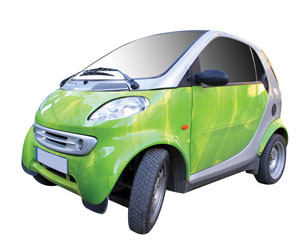Module 1—Motion
Lesson 2—The Language of Motion: Working with Displacement, Velocity, and Acceleration Vectors
 Get Focused
Get Focused

© Olaru Radian-Alexandru/shutterstock
A Smart car has more than two accelerators.
How many accelerators are there in a Smart car? (Hint: There are more than two.)
When a car is in motion, it changes position. The change in position is called a displacement. The car also travels with a given velocity, which may or may not be changing based on the acceleration. The terms displacement, velocity, and acceleration may not be as familiar to you as distance and speed. The collection of terms that make up the language of motion is perhaps larger than you think.
distance: the length of the path taken to move from one place to another
speed: distance travelled per unit of time
Lesson 1 challenged you to determine how distance, a familiar scalar quantity, was different than the vector quantity displacement. You did this by considering both quantities in a chuckwagon race and then using simulations to clarify the concepts. You expanded those ideas by considering their impact on both speed and velocity.
In this lesson and related lab activities you will not only review these ideas but clarify their use as you explore the following questions:
-
How are speed and velocity calculated?
-
What is the relationship between velocity and acceleration?
 Module 1: Lesson 2 Assignments
Module 1: Lesson 2 Assignments
Your teacher-marked Module 1: Lesson 2 Assignment requires you to submit a response to the following:
-
Lab—LAB 4, LAB 6, LAB 8, LAB 10, LAB 13, LAB 15, LAB 17, and LAB 18
-
Try This—TR 2, TR 3, TR 4, and TR 5
You must decide what to do with the questions that are not marked by the teacher.
Remember that these questions provide you with the practice and feedback that you need to successfully complete this course. You should respond to all the questions and place those answers in your course folder.